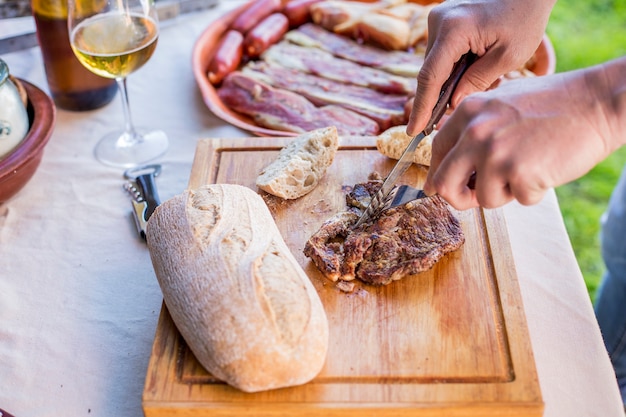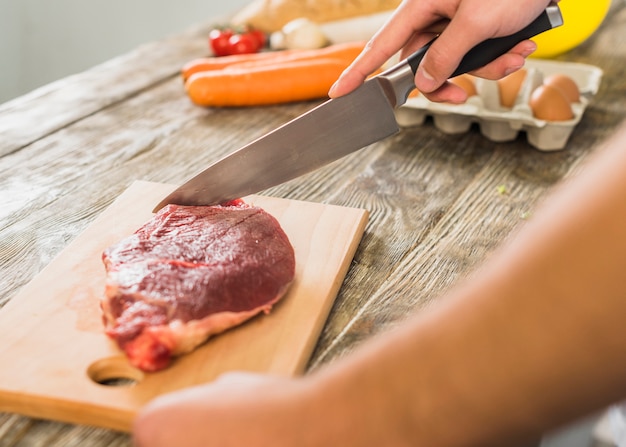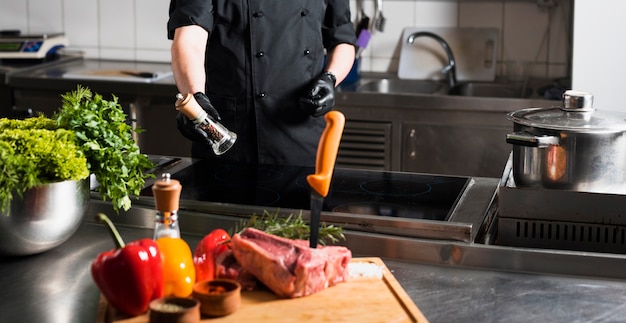Pork! It's a truly versatile ingredient, isn't it? From succulent roasts to juicy chops, crispy crackling to tender pulled pork, there's a pork dish for every occasion. But, let's be real, the one thing that can make or break your pork masterpiece is getting the cooking temperature just right. Overcook it, and you'll end up with dry, tough meat. Undercook it, and you're risking food poisoning. Not a good situation at all! So, let's dive into the world of safe pork cooking temperatures and how to ensure you're serving up a delicious and safe feast for yourself and your loved ones.
Part 1: The Science Behind Pork Cooking

Why is it so important to cook pork to the right temperature?
It all boils down to bacteria, my friend. Pork, like many other meats, can harbour a nasty little bug called Trichinella spiralis. This parasite can cause trichinosis, a potentially serious illness that can cause symptoms like muscle aches, fever, nausea, and diarrhoea. Don't worry, it's not common, but it's best to be safe! The good news is that cooking pork to the correct temperature eliminates this parasite, ensuring a safe and enjoyable meal.
What is the safe internal temperature for pork?
The Food Standards Agency recommends that pork should be cooked to an internal temperature of at least 145°F (63°C). This is the temperature at which Trichinella spiralis is killed off, ensuring the pork is safe to eat. You might hear some people say they prefer to cook pork to a higher temperature, but it's important to note that this is not necessary for safety. As long as you reach the minimum temperature, your pork is safe to eat.
Part 2: Your Essential meat thermometer

Okay, so you know the safe temperature, but how do you actually measure it? That's where the trusty meat thermometer comes in. It's a small investment that can save you a world of heartache (and potential food poisoning)! There are all sorts of types, from digital ones to instant-read ones, and even some fancy ones with Bluetooth connectivity. Personally, I love my instant-read thermometer. It's super quick and easy to use, and I can get a reading in just a few seconds. Whatever you choose, make sure it's accurate and calibrated properly. You can usually calibrate your thermometer by sticking it into a glass of ice water. It should read 32°F (0°C). If it doesn't, adjust it accordingly.
Using a Meat Thermometer
Using a meat thermometer is super simple. Just insert the thermometer into the thickest part of the meat, avoiding any bone, and check the temperature. It's a good idea to check a few different spots to ensure the entire piece of pork is cooked through. You can also insert the thermometer into the center of a roast or a thick chop. For thinner cuts like pork chops, you can insert the thermometer into the side of the meat, avoiding the bone.
Part 3: pork cuts and Their Ideal Cooking Temperatures

Now, here's the thing. While 145°F (63°C) is the minimum safe internal temperature, some cuts of pork benefit from being cooked to a slightly higher temperature for maximum tenderness and flavour. Let's take a look at some popular pork cuts and their ideal cooking temperatures:
Pork Chops
Pork chops are usually cooked to a medium temperature, about 145°F (63°C). You want them to be juicy and slightly pink in the centre. Overcooked chops will be dry and tough, so be sure to keep an eye on them! To get a beautiful crispy crust, you can sear the chops in a hot pan before finishing them in the oven.
A juicy, tender pork roast is a real treat, but it needs a bit longer in the oven. Aim for an internal temperature of 150°F (65°C) for a medium-rare roast, or 155°F (68°C) for a medium roast. For a succulent roast, it's best to cook it slowly at a low temperature, like 325°F (160°C). You can also use a meat thermometer to check the temperature of the roast at the end of cooking time, just to be sure it's reached the desired temperature.
Now, pork shoulder is perfect for slow cooking. This cut of pork benefits from being cooked to a higher temperature, around 190°F (88°C). This results in tender, melt-in-your-mouth meat, perfect for pulled pork sandwiches or a delicious roast. Slow cooking pork shoulder in a slow cooker or in the oven with some flavourful ingredients like onions, garlic, and herbs is a real winner. The long cooking time allows the tough connective tissue to break down, resulting in incredibly tender and flavorful meat.
Part 4: Cooking Methods for Pork
The way you cook your pork can affect the final temperature and the overall taste. Here are some popular methods to consider:
Baking
Baking is a great option for roasts, chops, and tenderloins. The oven provides even heat, allowing the pork to cook slowly and evenly. For a crispy skin, you can roast the pork on a rack in a roasting pan. This allows air circulation around the meat, resulting in that beautiful, crackling skin. If you want a juicier roast, you can place the pork on a bed of vegetables like onions, carrots, and potatoes. The vegetables will release moisture during cooking, keeping the pork moist and tender.
Pan-frying
Pan-frying is great for quick and easy meals. Heat a skillet over medium-high heat and sear the pork on both sides to create a crispy crust. Then, reduce the heat and cook until the pork reaches the desired internal temperature. For thinner cuts like pork chops, you can pan-fry them over medium heat for about 4-6 minutes per side. For thicker cuts, you can sear the meat first and then finish cooking it in the oven.
Grilling
Grilling adds a delicious smoky flavour to pork. Make sure your grill is clean and hot before you place the pork on the grill. Use a meat thermometer to check the internal temperature, as it can be tricky to judge the doneness visually. For grilling, you can use a gas grill or a charcoal grill. If you're using a gas grill, preheat the grill to medium heat. If you're using a charcoal grill, use a two-zone method. This means you'll have a hot side and a cooler side. Sear the pork on the hot side for a few minutes to create a nice crust, then move it to the cooler side to finish cooking.
Slow Cooking
This method is perfect for tough cuts of pork, like the shoulder. Slow cooking breaks down the tough connective tissue, resulting in incredibly tender and flavorful meat. Chuck the pork into your slow cooker with some flavourful ingredients like onions, garlic, and herbs, and let it simmer away for several hours. The slow cooker does all the work for you, resulting in a delicious, tender meal. You can use a slow cooker on low heat for 6-8 hours or on high heat for 3-4 hours. Just be sure to check the internal temperature of the pork before serving to make sure it's reached 190°F (88°C).
Part 5: The Signs of Properly Cooked Pork
Okay, you've cooked your pork, but how do you know it's done? Here are some signs to look for, but remember, the most accurate way to check for doneness is with a meat thermometer:
- Colour: The meat will have changed colour, becoming a pale grey inside. It won't be red anymore.
- Juices: The juices will run clear when you cut into the meat. If the juices are still pink, the meat needs to cook longer.
- Texture: The meat will feel firm to the touch, not springy or soft. If it feels soft, it's likely undercooked.
- Meat Thermometer: Of course, your trusty meat thermometer will confirm the internal temperature has reached at least 145°F (63°C).
Part 6: Resting is Key
Once your pork is cooked, don't rush to cut into it! Let it rest for at least 10 minutes before carving. This allows the juices to redistribute throughout the meat, resulting in a more tender and flavorful dish. Think of it as a little "relaxation time" for your pork! You can cover the cooked pork loosely with foil to keep it warm while it rests.
Part 7: pork safety Tips
Let's make sure we're handling and storing our pork properly for the ultimate in safety. Here's a quick rundown:
- Wash Your Hands: Always wash your hands thoroughly with soap and water after handling raw pork. Bacteria can easily spread from raw meat to other surfaces and to your hands, so it's important to wash your hands well.
- Separate Cutting Boards: Use separate cutting boards for raw pork and cooked food. This helps to prevent cross-contamination. I like to have a dedicated cutting board for raw meat and another for everything else. That way, I don't have to worry about contaminating my food.
- Refrigerator Storage: Store raw pork in the refrigerator at 40°F (4°C) or below. Store it on a low shelf so that it doesn't drip onto other foods. You can also wrap the pork tightly in cling film or store it in an airtight container.
- Room Temperature: Don't leave raw pork out at room temperature for more than two hours. Bacteria can multiply rapidly at room temperature, so it's important to keep raw pork refrigerated.
- Never Refreeze: Never refreeze thawed pork. This can increase the risk of foodborne illness. If you need to thaw frozen pork, you can do so in the refrigerator or in cold water. Just make sure to thaw it thoroughly before cooking.
Part 8: pork recipes
Now that you've got all the knowledge about safe pork cooking temperatures, you're ready to get cooking! Here are a few delicious pork recipes to get your taste buds tingling:
Pork Chops with Apple Sauce
This classic dish is simple to prepare and incredibly satisfying. Pan-fry the chops until golden brown, then bake them in the oven until cooked through. Serve with a sweet and tangy apple sauce for a perfect balance of flavours. You can even make your own apple sauce with just a few ingredients. Just simmer apples, sugar, cinnamon, and a little bit of lemon juice until the apples are soft and the sauce has thickened.
Slow-Cooked Pulled Pork Sandwiches
A crowd-pleasing favourite! Slow cook a pork shoulder with your favourite bbq sauce until it's falling off the bone. Pile the pulled pork on buns with coleslaw and pickles for a truly indulgent treat. You can use a slow cooker or a dutch oven to slow cook the pork. Just be sure to check the internal temperature of the pork before serving to make sure it's reached 190°F (88°C).
Crispy pork belly with Roasted Vegetables
This recipe is for those who appreciate a bit of decadence. Roast the pork belly until it's crispy and golden, and serve with a medley of roasted vegetables for a delicious and satisfying meal. You can use any type of vegetables for this recipe, but I like to use carrots, potatoes, onions, and Brussels sprouts. Roast them in the oven with the pork belly until they are tender and slightly caramelized.
Part 9: FAQs
Got any questions about pork? Here are some common ones and their answers:
Q: Can I cook pork to a lower temperature than 145°F (63°C)?
A: No! Cooking pork to a lower temperature can put you at risk of food poisoning. It's essential to cook pork to the recommended temperature of 145°F (63°C) to kill off harmful bacteria. While some people prefer to cook pork to a higher temperature for personal preference, it's not necessary for safety. Just make sure to reach the minimum temperature of 145°F (63°C) and you'll be good to go.
Q: What if I accidentally undercook pork? Can I reheat it?
A: It's best to avoid this scenario altogether. Reheating pork that has been undercooked won't necessarily kill off all the bacteria. If you're unsure about the doneness of your pork, it's best to cook it longer to be safe. It's better to err on the side of caution when it comes to food safety.
Q: How long can I keep cooked pork in the fridge?
A: Cooked pork can be kept in the fridge for up to 3-4 days. Make sure you store it in airtight containers or wrapped tightly in cling film to prevent contamination. It's important to keep cooked pork refrigerated to prevent bacteria growth.
Q: Can I freeze cooked pork?
A: Absolutely! Freezing cooked pork is a great way to extend its shelf life. Just make sure to wrap it tightly in freezer-safe packaging before freezing. You can freeze cooked pork for up to 2-3 months. To reheat frozen pork, you can thaw it in the refrigerator overnight or reheat it in the oven, microwave, or on the stovetop.
Q: How can I tell if cooked pork is still good to eat?
A: It's always a good idea to use your senses. If the pork smells sour or off, or has an unusual colour or texture, it's best to discard it. Trust your gut, and err on the side of caution. If you're unsure, it's best to throw it away. It's not worth the risk of getting sick.
Conclusion
Well, there you have it. Cooking pork safely and deliciously is a breeze with the right knowledge and a trusty meat thermometer. Remember, always cook pork to the recommended internal temperature of 145°F (63°C), and follow the safety tips to ensure a delicious and worry-free meal. Now, go on, grab some pork and get cooking! Let's make some delicious memories together.
Everyone is watching

Prime Rib Roast Cooking Time Chart: Per Pound Guide
Cooking TipsPrime rib roast. Just the name conjures images of lavish dinners, crackling fires, and hearty laughter. It’s ...

How Long to Bake Potatoes in the Oven (Perfect Every Time)
Cooking TipsBaked potatoes are a staple in my kitchen. They're incredibly versatile, delicious, and surprisingly easy to m...

Perfect Rice Every Time: The Ultimate Guide to Cooking Rice
Cooking TipsAs a self-proclaimed foodie, I've always been a bit obsessed with rice. It's the foundation of countless cuisi...

The Ultimate Guide to Cooking Asparagus: Tips, Techniques, and Recipes
Cooking TipsAsparagus. The mere mention of this spring delicacy conjures up images of vibrant green spears, crisp and burs...

Ultimate Guide to Cooking the Perfect Thanksgiving Turkey
Cooking TipsThanksgiving. Just the word conjures up images of overflowing tables laden with delicious food, the scent of r...
